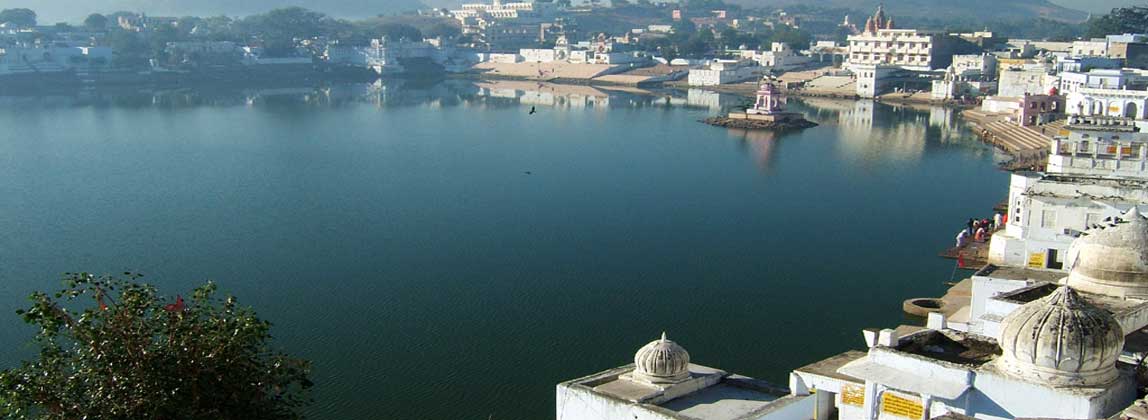


PUSHKAR- the 'Pilgrim City' is a picturesque town 14 kms. from Ajmer, known for its temples and lake, the Nag pahar (Snake Mountain), which forms a part of chain of the Aravali range, stands between Almer and Pushkar. The road from Almer to Pushkar is a very interesting drive as the road winds through the Nag Pahar, leading to the ancient lake. The town situated around the beautiful lake is surrounded on the three sides by hills, while the fourth side cordoned by the sands which have drifted from the plains of Marwar.
It is one of the most revered places of Hindus and referred as Tirth Raj' or the king among pilgrims, just as Banaras is their 'guru' or preceptor. No pilgrimage to Badri Narain (Himalayas), Jagannath (Orissa), Rameshwaram (Tamil Nadu) and Dwarka (Gujarat) the four principal Hindu places of pilgrimage is complete till the pilgrims bath in the sacred waters of Pushkar.
According to Pcidam Puran, the Hindu religious text, Lord Brahma was in search of suitable place for a Vedic yagna. While contemplating, a lotus fell down from his hand on the earth and water spurted from three places one of them was Pushkar and Brahma decided to perform his yagna over here.
The beautiful Pushkar Lake is a sanctified spot, and considered as old as the creation, and has been a place of pilgrimage since time immemorial, surrounded by 52 bathing ghats, where people come to take a dip with deep religious faith rooted in their hearts. Push kar has with stood the test of time, and has been a mute witness to the procession of history from the time of Rama, the hero of the earliest Hindu Epic Ramayana, to FaH ien's accounts of Pushkar in 4th century AD., and to the time of Muslim invasion.
JAGAT PITA SHRI BRAHMA TEMPLE - PUSHKAR- is a flourishing temple town full of religious myths and faiths, the biggest attraction being the temple of Lord Brahma-Lord of Creation; this is the only existing temple dedicated to Lord Brahma. It was constructed in 14th century, and stands on a high plinth with marble steps leading up to it.
A beautifully carved silver turtle sits on the floor facing the sanctum - sanctorum or garbha- griha. The marble floor around the silver turtle is embedded with hundreds of silver coins; silver coins with the donor's names engraved on them are also inset in the walls of temple.
Peacocks adorn the temple walls as they are believed to be the vehicle of Goddess Saraswati - the goddess of wisdom and consort of Lord Brahma. A small image of milkmaid Gayatri, flanks the four faced image of Lord Brahma and is known as Chaumurti. The sanctuary has silver doors inside a carved marble gateway. Steps in the corner lead to a small cave dedicated to Lord Shiv.
WARAH TEMPLE - The Warah temple houses an image of Lord Vishnu in the incarnation of wild boar. The temples of Lord Brahma and Warah are considered equally important. This ancient temple believed to be constructed by Chauhan King Anaji (1123-11.50), and was renovated by Gokul Chand Parikh a Scindia minister in 1806.
My thologically a very important temple and is believed that Lord Vishnu came on the earth in the incarnation of Warah (Wild boar) to kill the demon Hirnayaksh and liberate the land from his atrocities. After the Ajmer victory.
Mohammad Gauri destructed the temple.
SAVITRI TEMPLE - The temple of Lord Brahma's wife. It is located on the hill behind the Brahma temple and one has to climb a long series of steps to reach the shrine. It commands a panoramic view of the beautiful lake, and the picturesque surrounding of the villages.
TEMPLE OF RANGJI OR SHRIVAIKUNTHNATH -The
gracious temple is very conspicuous, due its south Indian style of architecture. It has a high rising 'Gopuram' typical southern India.
Pushkar has more than 400 temples, the other important temples are Baiji ka Mandir and Man Mandir etc.
MAN MAHAL - Raja Man Singh-l of Amer, built this largest royal house in Pushkar located on the east of Sarovar, the sacred lake in Pushkar. It gives a clear view of the banks and temples located around the lake. It was built as a royal guest house for Raja Man Singh I on his trips to the holy town. This traditional guest house has now been converted into a hotel, run by Rajasthan Tourism Development Corporation.
PUSHKAR LAKE - The pious Pushkar lake, believed to have been created by the falling of lotus from the hand of Lord
Brahma. It is considered to be as old as the creation.
As per the Hindu Mythology there are Panch Sarovar (Five
Lakes) namely Man sarovar, Bindu Sarovar, Narayan Sarovar,
Pampa Sarovar and Pushkar Sarovar.
The lake is considered one of the most sacred spots, and believed that one dip in the waters of lake on Kartik Poornima, is equivalent to performing yagnas for several hundred years.
The charming lake amidst the hills has 52 bathing ghats, built around the lake. The water around each ghat is supposed to have special powers. The Naga Kund is believed to give fertility, Roop Tirth gives beauty and charm, kapil Vyapi Kund water helps in curing leprosy and a dip in the Mrikand Muni Kund grants the boon of Wisdom, The other important ghats are the Varah Ghat which is very sacred as Lord Vishnu is believed to have appeared here in the form of boar, the Brahma and Gau Ghat. A dip in the lake by a woman absolves her and her husband both.
For complete cleansing of sins, three twilights must be passed at the pious city with baths at three ghats. Photography is prohibited on the ghats of the Pushkar Lake, while people bathing in the lake.